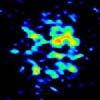 |
Livermore CA (SPX) Apr 21, 2005 The oxygen and magnesium content of some of the oldest objects in the universe are giving clues to the lifetime of the solar nebula, the mass of dust and gas that eventually led to the formation of our solar system. By looking at the content of chondrules and Calcium Aluminum- rich inclusions (CAIs), both components of the primitive meteorite Allende, Lab physicist Ian Hutcheon, with colleagues from the University of Hawaii at Manoa, the Tokyo Institute of Technology and the Smithsonian Institution, found that the age difference between the two fragments points directly to the lifetime of the solar nebula. CAIs were formed in an oxygen-rich environment and date to 4.567 billion years old, while chondrules were formed in an oxygen setting much like that on Earth and date to 4.565 billion, or less, years old. "Over this span of about 2 million years, the oxygen in the solar nebula changed substantially in its isotopic makeup," Hutcheon said. "This is telling us that oxygen was evolving fairly rapidly." The research appears in the April 21 edition of the journal Nature. One of the signatures of CAIs is an enrichment of the isotope Oxygen 16 (O-16). An isotope is a variation of an element that is heavier or lighter than the standard form of the element because each atom has more or fewer neutrons in its nucleus. The CAIs in this study are enriched with an amount of O-16 4 percent more than that found on Earth. And, while 4 percent may not sound like much, this O-16 enrichment is an indelible signature of the oldest solar system objects, like CAIs. CAIs and chondrules are tens of millions of years older than more modern objects in the solar system, such as planets, which formed about 4.5 billion years ago "By the time chondrules formed, the O-16 content changed to resemble what we have on Earth today," Hutcheon said. In the past, the estimated lifetime of the solar nebula ranged anywhere from less than a million years to 10 million years. However, through analysis of the mineral composition and oxygen and magnesium isotope content of CAIs and chondrules, the team was able to refine that time span to roughly 2 million years. "In the past the age difference between CAIs and chondrules was not well-defined," Hutcheon said. "Refining the lifetime of the solar nebula is quite significant in terms of understanding how our solar system formed." Community Email This Article Comment On This Article Related Links DOE/Lawrence Livermore National Laboratory SpaceDaily Search SpaceDaily Subscribe To SpaceDaily Express Nuclear Space Technology at Space-Travel.com
 Manchester, UK (SPX) Apr 07, 2005
Manchester, UK (SPX) Apr 07, 2005Astronomers using the National Science Foundation's Very Large Array (VLA) radio telescope are taking advantage of a once-in-a-lifetime opportunity to watch an old star suddenly stir back into new activity after coming to the end of its normal life. |
|
| The content herein, unless otherwise known to be public domain, are Copyright 1995-2006 - SpaceDaily.AFP and UPI Wire Stories are copyright Agence France-Presse and United Press International. ESA PortalReports are copyright European Space Agency. All NASA sourced material is public domain. Additionalcopyrights may apply in whole or part to other bona fide parties. Advertising does not imply endorsement,agreement or approval of any opinions, statements or information provided by SpaceDaily on any Web page published or hosted by SpaceDaily. Privacy Statement |